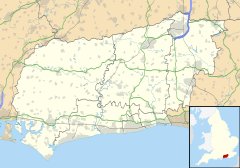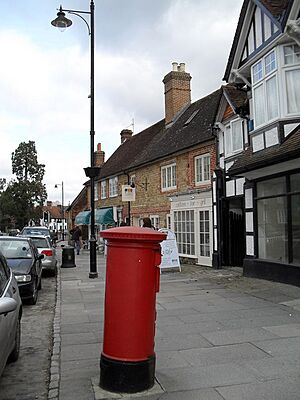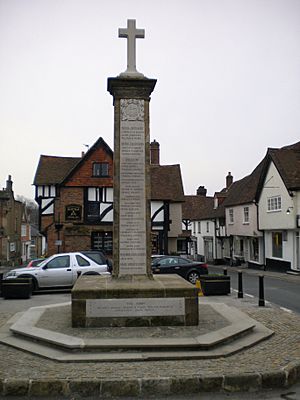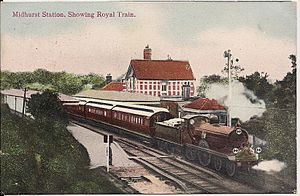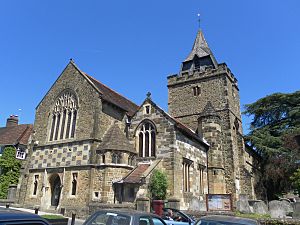Midhurst facts for kids
Quick facts for kids Midhurst |
|
|---|---|
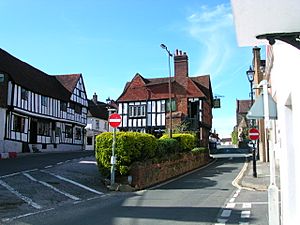 Midhurst from the south |
|
| Area | 3.33 km2 (1.29 sq mi) |
| Population | 4,914 (2011) |
| • Density | 1,467/km2 (3,800/sq mi) |
| OS grid reference | SU885214 |
| • London | 45 miles (72 km) NE |
| Civil parish |
|
| District |
|
| Shire county | |
| Region | |
| Country | England |
| Sovereign state | United Kingdom |
| Post town | MIDHURST |
| Postcode district | GU29 |
| Dialling code | 01730 |
| Police | Sussex |
| Fire | West Sussex |
| Ambulance | South East Coast |
| EU Parliament | South East England |
| UK Parliament |
|
| Website | http://www.midhurst-tc.gov.uk/ |
Midhurst is a historic market town and civil parish in West Sussex, England. It sits on the River Rother. The town is about 20 miles (32 km) from the English Channel. It is also about 12 miles (19 km) north of Chichester.
The name Midhurst was first written down in 1186. It was called Middeherst. This name means "Middle wooded hill" or "place among the wooded hills." It comes from old English words. Midd means "in the middle," and hyrst means "a wooded hill."
The old St. Ann's Castle was built around 1120 by the Normans. Today, only its foundations can be seen. The castle, the parish church of St. Mary Magdalene and St. Denis, and South Pond are the oldest structures. South Pond was once a fish-pond for the castle. The parish church is the oldest building in Midhurst. Across the River Rother, you can find the ruins of Tudor Cowdray House.
Contents
- How Midhurst is Governed
- What Midhurst Does for Work
- Fun Things to Do in Midhurst
- Midhurst's Past
- Midhurst's Landscape
- Important Places in Midhurst
- Listed Buildings in Midhurst
- Getting Around Midhurst
- News and Media
- Schools in Midhurst
- Places of Worship
- Twin Towns
- Sports in Midhurst
- Famous People from Midhurst
- See also
How Midhurst is Governed
National Government
Midhurst is part of the Chichester area for national elections. This area chooses a Member of Parliament (MP) to represent them. The MP works in the House of Commons in London. Since 2024, the MP for this area is Jess Brown-Fuller. She is from the Liberal Democrat party.
Local Government
Midhurst is part of the Chichester District. It is also part of West Sussex County. These areas have councils that manage local services. The Chichester District Council and West Sussex County Council look after things like roads and parks. Midhurst has two councillors on the Chichester District Council. They are both Liberal Democrats.
Town Council
The Midhurst Town Council helps run the town. It has 15 members who are chosen by local people. The council meets every month. A chairperson leads the council meetings. The council has a small staff to help with its work.
The Town Council plans many fun events for the community. These include street parties in December and August. They also organize "Big Cleans" to tidy up the town. The council looks after the town's recreation ground and cemetery. They also give money to local clubs. In 2014, the Town Council moved its offices. They are now in the Old Library building on Knockhundred Row.
What Midhurst Does for Work
Midhurst is a market town. It serves the countryside around it. Many small businesses, shops, restaurants, and cafes are here. The main jobs are in retail, construction, hotels, and office work. In 2011, Midhurst had 4,914 people. Most people who were not working were retired.
From 1913 to 1985, the Midhurst Brickworks was famous. It made special "Midhurst White" bricks. There is also an area in the south of Midhurst for light industry.
Fun Things to Do in Midhurst
Culture and Arts
The Midhurst Music, Arts and Drama Festival (MADhurst) is a big yearly event. It shows off the creative talent in Midhurst. It lasts for ten days each summer. It ends with a Carnival Parade and a big party at the Midhurst Sports Ground. The festival has concerts, art shows, and craft fairs. There are also family fun days, theatre, and dance. Many workshops teach creative skills. The whole community helps to run the festival.
The Midhurst Medieval Festival happens every May. It takes place in the Old Town. You can see re-enactments and falconry. There are also demonstrations of spinning and weaving. You can even try archery. The festival has medieval music, stalls, and food.
Historic Buildings Midhurst has many old buildings from the Tudor, Georgian, and Victorian times. There are 94 listed buildings. These buildings are special because of their history or design. The Midhurst Society works to protect these old buildings. They also try to make the local area better. They publish a magazine called "Midhurst Magazine."
Local Groups The Knockhundred Shuttles are a Morris Dancing club from Midhurst. They practice regularly and perform at festivals. The Midhurst Players put on plays several times a year. The Midhurst Art Society and Camera Club have summer shows. The Midhurst Choral Society performs concerts.
Midhurst on Screen In 2010, Midhurst was used for filming the TV show Foyle's War. In 2014, the town made its own "Midhurst Happy Video." This video was based on a song by Pharrell Williams.
Online Presence Midhurst has a Town Council website and a "VisitMidhurst" website for tourists. It also has community pages on Facebook, Twitter, and Pinterest. Many local groups also have their own websites and social media pages.
Community Places
The South Downs National Park was created in 2011. It stretches for about 87 miles (140 km). It goes from Winchester in the west to Eastbourne in the east. The park covers a large area of beautiful landscapes. The main office for the National Park is in Capron House, Midhurst. This building is also a community center. It has an exhibition about the park and a tourist information center.
The Midhurst Town Trust is a charity. It looks after some of Midhurst's community places. These include the Old Town Hall and the Market Square. They also care for old items like the Stocks and the Town Mace. The Trust has six people who manage it.
The Grange Leisure Centre opened in 2014. It replaced an older building. This center has many services under one roof. It is a place for clubs like bridge, badminton, and yoga. It has a sports hall, a fitness room, and squash courts. There is also a dance studio and a health suite with a sauna. The center has a community hall, rooms, a bar, and a cafe. It looks out over South Pond.
Health and Library Midhurst Community Hospital provides health services. The local library is inside The Grange Leisure Centre. The Midhurst Register Office is also there. You can register births, marriages, and deaths there.
Clubs and Societies Midhurst has over fifty clubs and societies. They cover many interests. These include arts, crafts, environment, and sports. There are also groups for social support.
Midhurst's Past
Midhurst grew from a Saxon village. It was at an important crossroads. These are now the A272 and A286 roads. There might have been a village here since Roman times. After the Norman Conquest, a castle was built on St Ann's Hill. This hill was a good spot to watch over the river and roads. St Ann's Hill might have been an Iron Age fort even earlier.
Most buildings in the Old Town are from the 1500s. Some parts of buildings, like the Spread Eagle Hotel, are even older. North Street also has Tudor buildings hidden behind newer fronts. These were added in the 1600s and 1700s when the town was doing well. In the 1900s, more houses were built in the south of the town.
Early History
In 1106, Savaric fitz Cana got land in Midhurst. Around 1158, his son built a fortified house on St. Anne's Hill. Later, the family moved. They built a new main home across the River Rother. This new place was called Coudreye, meaning "hazel grove." Between 1284 and 1311, St Ann's Castle was mostly taken apart.
The church in Midhurst started as a small chapel. It became a parish church around 1536. It was then largely rebuilt. The town grew around the castle. It provided services and a market for local farmers. The earliest record of the market is from 1223. People would sell their produce there. Wool, cloth, and leather were important trades.
Midhurst was a "free borough." This meant it had some self-rule. It was run by a bailiff chosen by the townspeople. The bailiff managed the market. In 1409, an agreement was made. The townspeople paid money to the Lord of the Manor. In return, they could collect market tolls. They also held courts in his name.
Midhurst sent two members to the Parliament from 1382. The people who could vote owned special properties. These properties were marked by "burgage stones." One of these stones can still be seen today.
Later History

A big change in the 1500s was the rebuilding of Cowdray House. Sir David Owen started building it in the 1520s. The Fitzwilliam family bought it in 1529. They were a Catholic family. They spent a lot of money on the house. It was finished around 1540. The estate needed a lot of food for its many servants and visitors. Building the house also brought many artists and craftspeople to Midhurst. This helped the town's economy grow.
Two wall paintings in the town are thought to be by artists who worked on Cowdray House. One is in the Olive and Vine Restaurant. The other is in Elizabeth House. They might have been practice images or payment for rent. The painting in North Street shows a story from the Bible. It might show how the Catholic people of the town felt about not being allowed to practice their religion.
The town grew towards the new mansion. New shops and houses were built on North Street. The Angel Hotel was built as a coaching inn. It hosted many of the Pilgrim Fathers on their way to Plymouth.
In 1605, the owner of Cowdray House, Anthony-Maria Browne, 2nd Viscount Montagu, was arrested. He was suspected in the Gunpowder Plot. He was Catholic and knew some of the plotters. He had even hired Guy Fawkes for a short time. He was in the Tower of London for about a year. He is buried in Midhurst Church.
In the 1630s, Robert May was the chef at Cowdray House. He published one of the first British cookbooks. In 1637, a court case mentioned people in Midhurst playing cricket during church. This is one of the earliest mentions of the sport.
By the mid-1600s, the Anglican church was strong. But many families in Midhurst were still Catholic or other Protestants. In 1642, during the English Civil War, many men in Midhurst signed a paper supporting the Anglican Church. But some Catholics refused at first.
Modern Times
In 1831, Midhurst had very few voters. It was called a "rotten borough." In 1832, the Great Reform Act changed things. Midhurst was allowed only one Member of Parliament. The voting area was made much larger.
The Montagu family owned Cowdray House until 1843. Then it was bought by the Earl of Egmont. In 1910, Sir Weetman Dickinson Pearson bought it. He later became Viscount Cowdray. The current owner is the 4th Viscount.
In 2002, Country Life magazine said Midhurst was the second best place to live in Britain.
Midhurst's Landscape
Midhurst is in an area called the Wealden Greensand. This area is between the South Downs and the Low Weald. The South Downs have open, rolling chalk hills. The western Weald has wooded slopes and steep valleys. The rocks around Midhurst are sedimentary. The town sits on Sandgate Formation rocks. These are part of the Lower Greensand Group. The southern parts of town are on Folkestone Formation sandstones. The area also has river deposits like gravels, sands, and silts.
Important Places in Midhurst
South Pond is the second oldest structure in Midhurst. Only St. Ann's Castle is older. It was likely created in the early 1100s. It was a fish-pond for the castle. The South Mill was near the pond by 1284. It first ground corn. Later, it was used for leather production. The pond has had problems with pollution and silting.
The South Pond Group was started in 2012. They work to protect the area around the pond. They clean it, check water quality, and educate people. In 2014–2015, major work was done. The pond was dredged and new plants were added. This helped to bring back the natural wildlife.
The Midhurst War Memorial is outside the parish church. It honors those who died in wars. Major Harold Pearson gave the land for it. A local stonemason, Mr. Percy Oliver, built it. Sir Ashton Webb designed it. It was unveiled in 1923. It lists the names of 50 men who died in World War I. Names from World War II were added later. In 2014, a name from the Afghan War was added. The Town Trust cares for the Memorial. Each year, a service is held there on Remembrance Sunday.
Listed Buildings in Midhurst
Midhurst has 106 buildings listed by Historic England. These buildings are special because of their history or design. The ruins of St. Ann's Castle are also a Scheduled Monument. The Parish Church of St. Mary Magdalene and St. Denis and the Spread Eagle Hotel are very important. Most other listed buildings are also important. At least 42 of these buildings are in the Old Town. Many of them date back to the 16th, 17th, and 18th centuries.
Getting Around Midhurst
Trains
Midhurst used to have three train lines. One came from Pulborough (1866). Another came from Petersfield (1864). A third came from Chichester (1881). The line from Chichester closed to passengers in 1935. All passenger services stopped in 1955. The last goods trains ran in 1964.
Roads and Buses
The A272 road goes through Midhurst from east to west. The A286 road goes through from north to south.
Four regular bus routes serve the town. Stagecoach runs buses to Chichester, Guildford, and Worthing. Emsworth runs a bus to Petersfield.
News and Media
Local news and TV shows come from BBC South and ITV Meridian. TV signals are received from the Midhurst TV transmitter.
Local radio stations include BBC Radio Sussex and Heart South. There is also Greatest Hits Radio West Sussex and V2 Radio. The local newspaper is the Midhurst and Petworth Observer. It comes out on Thursdays.
Schools in Midhurst
The main secondary school in Midhurst is Midhurst Rother College. It used to be a grammar school, founded in 1672. It became an Academy school in 2009. In 2012/13, it was rated "outstanding" by Ofsted. Girls first joined the school in 1956.
Midhurst also has a state primary school. It is the Church of England Primary School. Other primary schools are in nearby Easebourne and Stedham. Easebourne also has a private primary school called Conifers.
Places of Worship
The Midhurst Deanery is part of the Church of England. It includes 22 churches in the Rother Valley.
The Anglican parish church is St Mary Magdalene and St Denys. It is in the market square and is a listed building. The church has been changed a lot over time. The base of its tower is from the 1200s. Other parts were rebuilt in the 1400s and 1800s.
The Roman Catholic church is the Church of the Divine Motherhood and St Francis of Assisi. It was built in 1957. It replaced an older church. The new building is made of sandstone. It has a tall, separate bell tower.
Midhurst Methodist Church is an old building with a large window. There is also a Kingdom Hall for Jehovah's Witnesses.
Twin Towns
Midhurst has two "twin towns" or "sister cities." These are towns in other countries that have a special friendship with Midhurst.
- Baiersbronn, Germany
- Nogent-le-Rotrou, France
Sports in Midhurst
The Midhurst Sports Association (MSA) manages the Sports Pavilion. This is on the Midhurst Sports Ground, near Cowdray Ruins. The MSA also supports the Midhurst Cricket, Rugby, and Stoolball Clubs.
The Midhurst and Easebourne Football Club is a local football team. Their ground is in the nearby village of Easebourne. There are also youth football teams and a walking football club for older people.
Famous People from Midhurst
- Richard Cobden (1804–1865) was a politician. He was born nearby and went to school in Midhurst.
- Charles James Fox (1749–1806) was a Member of Parliament for Midhurst.
- Boris Karloff (1887–1969), a British horror actor, died in Midhurst.
- King Henry VIII visited Midhurst in 1538 and 1545. His children, Edward VI and Elizabeth I, also visited.
- Vic Mitchell (1934–2021), an author, lived in Midhurst for many years.
- Anya Seton (1904–1990) stayed at the Spread Eagle Hotel. She was researching her novel Green Darkness, which features Cowdray House.
- Hugh Pollard (1888–1966), a secret agent, retired to Midhurst.
- H.G. Wells (1866–1946), the famous writer, was a student and teacher at Midhurst Grammar School. Midhurst appears in his novels as "Wimblehurst."
- Alec Guinness (1914–2000), a famous actor, died in Midhurst.
See also
 In Spanish: Midhurst para niños
In Spanish: Midhurst para niños


